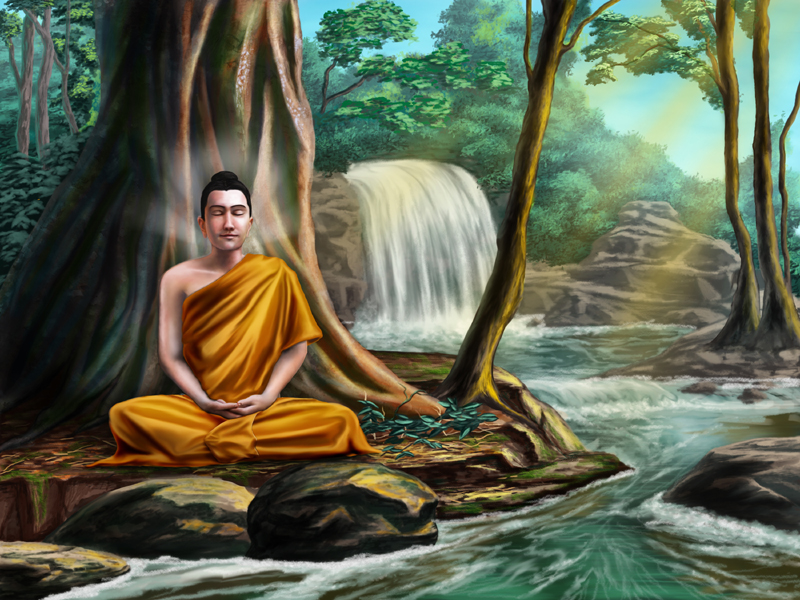
Mythology is a swarm of stories, legends, beliefs, and rituals that express the identity and roots of religion or culture. Nature or ecology is the collective word for all the physical, material, and environmental features of this universe. Ecology and mythology are two basic pillars of any person’s journey on this blue planet. Though not obvious, our relationship with our environment is hugely based on our beliefs and our beliefs are hugely based on nature. Hence mythology and ecology have a deeper bond than we actually perceive. There have been various mythologies over centuries. But let’s talk about a few of the mythologies that are nature-friendly.
Jainism
Jainism is one of the ancient religions that believe in “Non-ahimsa”. It has its roots in India. Similar to other Indian mythologies, This one believes in reincarnation or re-birth minding the aspects of karma. Jains believe that bad karma happens when we hurt other living beings. The five guiding principles of Jainism are ahiṃsā (non-violence), Satya (truth), asteya (not stealing), brahmacharya (sexual continence), and aparigraha (non-possessiveness). Jain dharma believes in “Non- violence” above all. It can be regarded as the founding principle of this faith system. Jains believe that all plants and animals and even a few non-living beings have souls like humans. They do no harm to animals, plants, fellow humans, or mother nature.
Nature- friendly Jainism

Source: Twitter.com
Every ardent follower of Jain follows compassion to all forms of living beings, Often referred to as “Jiv-daya”. Jains are strict followers of vegetarianism. In fact, they do not even eat vegetables that grow under-ground. Monks and nuns of Jains wear muhpatti, a squared white cloth or card worn around the mouth. While some may think that it is for the reduction of sound, it actually has a deeper significance than this. It is worn to avoid the unwilling killing of insects in the process of breathing. They also avoid wearing footwear to kill ants and other micro crawlers. Jain monks and nuns avoid sweeping for the same reason. No Jain is allowed to squat or kill mosquitoes. Wastage of food and natural resources is considered bad karma in Jainism.
Even after centuries of this religion, the beliefs support and are valid still date. Way ahead of its time, this religion was born when there were no ecological issues on earth yet it turned ecology into religion. Jains today across the world are forefronts in teaching everyone about the importance of patience, compassion, and forgiveness.
Buddhism
Buddhism is a very widespread religion today. It does not only teach about the ending of one’s personal suffering but also about the environment and how we all can support sustainability. Buddhism finds its basis on the eightfold path. The Eightfold Path consists of eight practices: right view, right resolve, right speech, right conduct, right livelihood, right effort, right mindfulness, and right samadhi.
Nature – friendly Buddhism
Buddhism and nature have a long history of bonding. Gautama Buddha, the founder of Buddhism attained enlightenment under a fig tree. Buddhism promotes meditation in nature. To breath and be present in the silence of nature. Buddhists have a different approach to animals when compared to an ordinary man. They avoid taming animals using weapons. They use love, kindness, and compassion to get closer to animals. Gauthama Buddha was an ardent advocate of animal rights. Buddhism believes in non-violence just like Jainism. Animal sacrifice is considered a sin.

Source: Zenlife
The Buddhist’s monastic avoids harming nature as much as possible. Even when urinating in a remote area, monks are advised to find a place that has no fresh grass. They also are advised to not travel during rainy seasons as it can cause agricultural damage. Buying caged birds and freeing them has been a well-known practice in Buddhism implying the fact that every being needs freedom.
Buddhism has been prevalent for many years now. Its teachings are profound and well known. Treating plants and animals the right way can create a sustainable nature as well as a healthy mindset. We need to apply these rules in our normal lives as much as possible to become eco-friendly.
Do we care about mythology and its relationship with ecology?
As told earlier, ecology and mythology go hand to hand. It is important we ask ourselves if we agree with all the fables and teachings of the mythologies told to us. We need to ask if we are following the eco-friendly way. Nature is our place of birth, living, and stay. We have a relationship with nature way longer than any other relationship. Let us take time to understand ecology and the way mythology teaches us that.
To read more articles related to mythology click here.
To read more articles related to nature click here.






[…] Here is another article related to mythology for you. […]